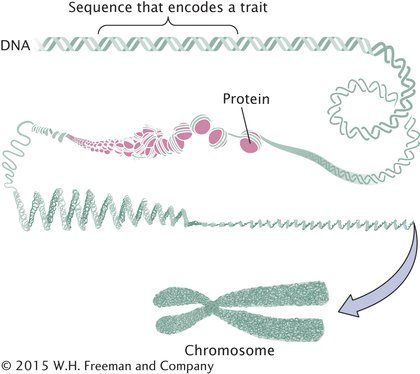1.3 A Few Fundamental Concepts Are Important for the Start of Our Journey into Genetics
Undoubtedly, you learned some genetic principles in other biology classes. Let’s take a few moments to review some fundamental genetic concepts.
Cells are of two basic types: eukaryotic and prokaryotic. Structurally, cells consist of two basic types, although, evolutionarily, the story is more complex (see Chapter 2). Prokaryotic cells lack a nuclear membrane and do not generally possess membrane-
bounded cell organelles, whereas eukaryotic cells are more complex, possessing a nucleus and membrane- bounded organelles such as chloroplasts and mitochondria. The gene is the fundamental unit of heredity. The precise way in which a gene is defined often varies depending on the biological context. At the simplest level, we can think of a gene as a unit of information that encodes a genetic characteristic. We will expand this definition as we learn more about what genes are and how they function.
Genes come in multiple forms called alleles. A gene that specifies a characteristic may exist in several forms, called alleles. For example, a gene for coat color in cats may exist as an allele that encodes black fur or as an allele that encodes orange fur.
Genes confer phenotypes. One of the most important concepts in genetics is the distinction between traits and genes. Traits are not inherited directly. Rather, genes are inherited and, along with environmental factors, determine the expression of traits. The genetic information that an individual organism possesses is its genotype; the trait is its phenotype. For example, the albinism seen in some Hopis is a phenotype, and the information in OCA2 genes that causes albinism is the genotype.
Genetic information is carried in DNA and RNA. Genetic information is encoded in the molecular structure of nucleic acids, which come in two types: deoxyribonucleic acid (DNA) and ribonucleic acid (RNA). Nucleic acids are polymers consisting of repeating units called nucleotides; each nucleotide consists of a sugar, a phosphate group, and a nitrogenous base. The nitrogenous bases in DNA are of four types: adenine (A), cytosine (C), guanine (G), and thymine (T). The sequence of these bases encodes genetic information. DNA consists of two complementary nucleotide strands. Most organisms carry their genetic information in DNA, but a few viruses carry it in RNA. The four nitrogenous bases of RNA are adenine, cytosine, guanine, and uracil (U).
Page 12 1.14 Genes are carried on chromosomes.
1.14 Genes are carried on chromosomes.Genes are located on chromosomes. The vehicles of genetic information within a cell are chromosomes (Figure 1.14), which consist of DNA and associated proteins. The cells of each species have a characteristic number of chromosomes; for example, bacterial cells normally possess a single chromosome; human cells possess 46; pigeon cells possess 80. Each chromosome carries a large number of genes.
Replicated chromosomes separate through the processes of mitosis and meiosis. The processes of mitosis and meiosis ensure that a complete set of an organism’s chromosomes exists in each cell resulting from cell division. Mitosis is the separation of replicated chromosomes in the division of somatic (nonsex) cells. Meiosis is the pairing and separation of replicated chromosomes in the division of sex cells to produce gametes (reproductive cells).
Genetic information is transferred from DNA to RNA to protein. Many genes encode characteristics by specifying the structure of proteins. Genetic information is first transcribed from DNA into RNA, and then RNA is translated into the amino acid sequence of a protein.
Mutations are changes in genetic information that can be passed from cell to cell or from parent to offspring. Gene mutations affect the genetic information of only a single gene; chromosome mutations alter the number or the structure of chromosomes and therefore usually affect many genes.
Many traits are affected by multiple factors. Many traits are affected by multiple genes that interact in complex ways with environmental factors. Human height, for example, is affected by many genes as well as by environmental factors such as nutrition.
Evolution is genetic change. Evolution can be viewed as a two-
step process: first, genetic variation arises, and second, some genetic variants increase in frequency, whereas other variants decrease in frequency.  TRY PROBLEM 21
TRY PROBLEM 21